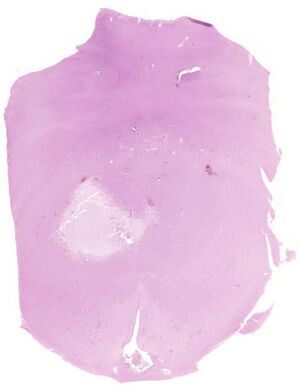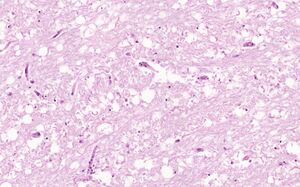5. Encephalomalacia alba
Staining: HE
Organ: Brain
Description:
You can clearly see an area that is different from the rest. This area has no nuclei, is pale and has loose parenchyme. There are hypereosinophilic neurons with karyopyknosis (shrinkage of the nuclei).
Diagnosis: Encephalomalacia alba
Theory:
There are three types of encephalomalacia. Alba (white), flava (yellow) and rubra (red). Alba is “fresher”, more recent than the flava type, and will become the flava type over time. The name of the rubra comes from the bleeding that accompanies it. The first two are examples of anemic “infarction” while the rubra is a type of haemorrhagic “infarction”.
The hypereosinophilic neurons are called red neurons. Neurons are very sensitive to hypoxia, so they are the first to be damaged during hypoxia.
The alba and flava are caused by a blockage of cerebral artery by:
- Thrombosis
- Embolization
- Vasculitis
The rubra type is caused by venous obstruction by:
- Sinus thrombosis
- Cerebral tumor
- Cerebral abscess


